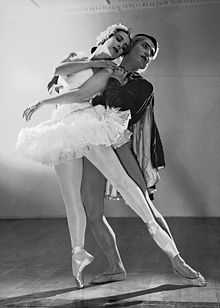Ballets de cour
Ballets de cour (court ballet) is the name given to ballets performed in the 16th and 17th centuries at court. Jean-Baptiste Lully is considered the most important composer of music for ballets de cour and was instrumental to the development of the form. During his employment by Louis XIV as director of the Académie Royale de Music, he worked with Pierre Beauchamp, Molière, Philippe Quinault and Mademoiselle De Lafontaine (the first professional female dancer and premiere danseuse of the Paris Opera Ballet) to develop ballet as an art form equal to that of the accompanying music.
Beauchamp, superintendent of the ballet and director of the Académie Royale de Danse, codified the five positions based on the foundations set down by Thoinot Arbeau in his 1588 Orchesographie. Emphasising the technical aspects of dance, Beauchamp set out the first rules of ballet technique. The emphasis on turned out legs, light costumes, female dancers and long dance sequences (all first seen in L'Europe galante (1697)) with light, flexible footwear was a turning point in ballet practice that led to the pre romantic ballet era. Pierre Rameau expanded on Beauchamp's work in Dancing master (1725), further detailing carriage of the body, steps and positions.
The ballets de cour developed into the comédie-ballet and then the opéra-ballet during the course of the 18th century. This was a fully operatic form that included ballet as a prominent feature of the performance. Jean-Philippe Rameau's Les Indes galantes (1735) is considered to be the work that signaled the divergence of social (ballroom) dance and ballet.
See also
- Ballet Comique de la Reine
- Ballet timeline
- Baroque dance
- History of ballet
- History of dance
References
| ||||||||||||||||||||||||||||||||||||
